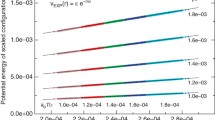Abstract
It was proven that after averaging over the canonical Gibbs ensemble, the mean perturbation energy was singled out of the classical partition function before the expansion in a series of perturbation theory. Therefore, the term that formally coincides with first order perturbation theory in a decomposition of the Helmholtz free energy bears no relationship to perturbation theory. Then the proper series of the thermodynamic perturbation theory always starts with a second order infinitesimal. Therefore, the wellknown condition of applicability of the thermodynamic perturbation theory, “...the requirement that the perturbation energy per particle be small compared with T...” (L. D. Landau and E. M. Livshits, Statistical Physics, Vol. V, Pt. I), can be substantially weakened. The most important factor for applicability of thermodynamic perturbation theory is the value of many-particle correlations in an unperturbed system, but not the smallness of the perturbation potential.
Similar content being viewed by others
References
H. N. V. Temperley, J. S. Rowlinson, and G. S. Rushbrooke (eds.), Physics of Simple Liquids [in Russian], North-Holland, Amsterdam (1971).
L. D. Landau and E. M. Livshits, Statistical Physics [in Russian], Vol. V, Pt. 1, Fizmatlit, Moscow (2005).
J. D. Weeks, D. Chandler, and H. C. Andersen, J. Chem. Phys., 30, No. 12, 5237–5247 (1971).
H. C. Andersen, J. D. Weeks, and D. Chandler, Phys. Rev. A, 4, No. 4, 1597–1607 (1971).
L. Verlet and J.-J. Weis, ibid., 5, No. 2, 939–952 (1972).
F. H. Ree, J. Chem. Phys., 64, No. 11, 4601–4605 (1976).
M. Ross, ibid., 71, No. 4, 1567–1571 (1979).
F. Lado, Mol. Phys., 52, No. 4, 871–876 (1984).
H. G. Kang, S. C. Lee, and T. Ree, J. Chem. Phys., 82, No. 1, 415–423 (1985).
J. A. Barker and D. Henderson, Rev. Mod. Phys., 48, No. 4, 587–673 (1976).
J. P. Hansen and I. R. McDonald, Theory of Simple Liquids, Third Edition, Elsevier (2006), p. 416.
J. A. Barker and D. Henderson, J. Chem. Phys., 47, No. 8, 2856–2861 (1967).
W. R. Smith, D. Henderson, and J. A. Barker, ibid., 53, No. 2, 508–515 (1970).
W. R. Smith, D. Henderson, and J. A. Barker, ibid., 55, No. 8, 4027–4033 (1971).
J. A. Barker and D. Henderson, Annu. Rev. Phys. Chem., 23, 439–450 (1972).
B. J. Alder, D. A. Young, and M. A. Mark, J. Chem. Phys., 56, No. 6, 3013–3029 (1971).
D. Henderson, O. H. Scalise, and W. R. Smith, ibid., 72, No. 4, 2431–2438 (1980).
J. Largo and J. R. Solano, J. Chem. Phys. B, 108, 10062–10070 (2004).
Yu. T. Pavlyukhin, J. Struct. Chem., 47,Supplem., S173–S190 (2006).
R. W. Zwanzig, J. Chem. Phys., 22, No. 8, 1420–1426 (1954).
B. J. Alder and W. Hoover, in: H. N. V. Temperley, J. S. Rowlinson, and G. S. Rushbrooke (eds.), Physics of Simple Liquids [in Russian], North-Holland, Amsterdam (1971), pp. 81–135.
Yu. T. Pavlyukhin, J. Struct. Chem., 41, No. 5, 988–1004 (2000).
Yu. T. Pavlyukhin, ibid., 48, No. 6, 1073–1081 (2007).
Yu. T. Pavlyukhin, ibid., No. 1, 74–80.
Tabulated numerical data for approximations of the results of modeling are found at http://www.solid.nsc.ru.
Author information
Authors and Affiliations
Corresponding author
Additional information
Original Russian Text Copyright © 2009 by Yu. T. Pavlyukhin
__________
Translated from Zhurnal Strukturnoi Khimii, Vol. 50, No. 3, pp. 468–477, May–June, 2009.
Rights and permissions
About this article
Cite this article
Pavlyukhin, Y.T. Thermodynamic perturbation theory of simple liquids. J Struct Chem 50, 446–455 (2009). https://doi.org/10.1007/s10947-009-0067-2
Received:
Published:
Issue Date:
DOI: https://doi.org/10.1007/s10947-009-0067-2



